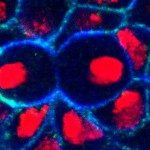Lien vers Pubmed [PMID] – 7601001
Development 1995 Jun;121(6):1875-84
Suppressor of Hairless (Su(H)) activity is zygotically required in larval imaginal discs for the singling out of adult sense organ precursor (SOP) cells: loss of Su(H) function results in too many proneural cluster cells adopting the SOP fate, while overexpression of the Su(H) protein prevents SOP specification. Su(H) null mutant alleles are recessive lethal at the late larval and early pupal stages. The development of Su(H) mutant cells in pupae was therefore studied in somatic clones. Clonal analysis first showed that Su(H) is required for the regular spacing of microchaete precursor cells, as clusters of mutant SOPs were detected at positions where singled out sense organ cells are normally found. Second, Su(H) mutant SOPs produced neuron-like cells, consistent with a late defect in Notch (N) signalling. Third, a careful cell-by-cell analysis of clone borders showed that Su(H) mutant cells may adopt the SOP fate even when directly adjacent to wild-type cells. Finally, quantitative clone border analysis indicates that the relative level of Su(H) gene dosage appears to bias the selection of the future SOP: cells with a higher level of Su(H) activity are more likely to adopt the epidermal fate. These results show that notum cells strictly require Su(H) activity for receiving the lateral inhibitory signal. Thus, the DNA-binding protein encoded by the Su(H) gene may act downstream of the N receptor to implement the epidermal, non-SOP fate.

